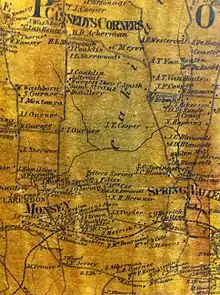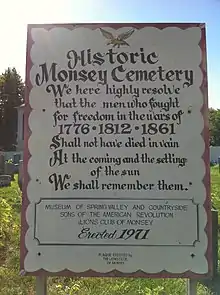Monsey, New York
Monsey (/ˈmʌnsi/) is a hamlet and census-designated place in the town of Ramapo, Rockland County, New York, United States, located north of Airmont; east of Viola; south of New Hempstead; and west of Spring Valley. The village of Kaser is completely surrounded by the hamlet of Monsey. The 2010 census listed the population at 18,412.
Monsey, New York | |
|---|---|
 Location in Rockland County and the state of New York | |
 Monsey Location within the state of New York  Monsey Monsey (the United States) | |
| Coordinates: 41°7′10″N 74°3′57″W | |
| Country | |
| State | |
| County | Rockland |
| Area | |
| • Total | 5.8 km2 (2.2 sq mi) |
| • Land | 5.7 km2 (2.2 sq mi) |
| • Water | 0.1 km2 (0.0 sq mi) |
| Elevation | 167 m (548 ft) |
| Population (2010) | |
| • Total | 18,412 |
| • Estimate (2017)[1] | 22,043 |
| • Density | 3,650/km2 (9,500/sq mi) |
| Time zone | UTC-5 (Eastern (EST)) |
| • Summer (DST) | UTC-4 (EDT) |
| ZIP Code | 10952 |
| Area code(s) | 845 |
| FIPS code | 36-48010 |
| GNIS feature ID | 0957535 |
| NWS SAME code | 036087 |
The hamlet has a large, and growing, community of Orthodox Jews.[2]
History
Rockland County was inhabited by the Munsee band of Lenape Native Americans, who were speakers of the Algonquian languages. Monsey Glen, a Native American encampment, is located west of the intersection of State Route 59 and State Route 306. Numerous artifacts have been found there and some rock shelters are still visible. The Monsey railroad station, which received its name from an alternate spelling of the Munsee Lenape, was built when the New York & Erie Railroad passed through the glen in 1841.[3]
In the 1950s, Monsey was a one stoplight town with a single yeshiva. By 1997, Monsey had 112 synagogues and 45 yeshivas.[4]
Located in Monsey is the Houser-Conklin House, listed on the National Register of Historic Places in 2010.[5]
On December 28, 2019 it was the site of a mass stabbing in the home of a Hasidic rabbi who was hosting a Hanukkah party, leaving five injured and one dead.[6]
Geography
Monsey is located at 41°7′10″N 74°3′57″W .[7]
According to the United States Census Bureau, the CDP has a total area of 2.2 square miles (5.8 km2), of which, 2.2 square miles (5.7 km2) of it is land and 0.04 square miles (0.1 km2) of it (0.90%) is water.
Demographics

| Historical population | |||
|---|---|---|---|
| Census | Pop. | %± | |
| 1970 | 8,797 | — | |
| 1980 | 12,380 | 40.7% | |
| 1990 | 13,986 | 13.0% | |
| 2000 | 14,504 | 3.7% | |
| 2010 | 18,412 | 26.9% | |
| 2017 (est.) | 22,043 | 19.7% | |
| Source:[1] | |||
As of the census[8] of 2017, there were 22,043 people, 3,984 households, and 2,596 families residing in the CDP. The population density was 6,554.3 per square mile (2,533.9/km2). There were 4,244 housing units at an average density of 1,400.0/sq mi (541.2/km2). The racial makeup of the CDP was 95.8% White, 3.0% African American, 0.03% Native American, 1.05% Asian, 0.01% Pacific Islander, 0.70% from other races, and 1.08% from two or more races. Hispanic or Latino of any race were 2.86% of the population. 43.98% speak English at home, 41.48% Yiddish, 6.88% Hebrew, 2.69% French or a French creole, 1.85% Spanish, and 1.24% Russian.[9]
There were 2,981 households, out of which 58.9% had children under the age of 18 living with them, 78.0% were married couples living together, 6.0% had a female householder with no husband present, and 12.9% were non-families. 10.6% of all households were made up of individuals, and 4.4% had someone living alone who was 65 years of age or older. The average household size was 4.74 and the average family size was 5.16. In the CDP, the population was spread out, with 48.6% under the age of 18, 10.5% from 18 to 24, 18.2% from 25 to 44, 16.3% from 45 to 64, and 6.4% who were 65 years of age or older. The median age was 19 years. For every 100 females, there were 106.8 males. For every 100 females age 18 and over, there were 106.6 males. The median income for a household in the CDP was $45,194, and the median income for a family was $45,911. Males had a median income of $41,606 versus $33,576 for females. The per capita income for the CDP was $14,000. About 25.4% of families and 30.6% of the population were below the poverty line, including 37.8% of those under age 18 and 9.2% of those age 65 or over.
Jewish Community
Monsey is a major center of Orthodox Judaism in the United States, along with the neighboring towns of Kiryas Joel, Kaser, Spring Valley, New Square, and Airmont.[2] It is the largest center of Hasidic Judaism in the United States outside of New York City, with approximately 5,400 households (4.2% of the world hasidic population).[10] The migration to Monsey began in the late 1940s when New York City’s Orthodox Jews were seeking affordable real estate for their quickly growing communities. These spaces offered the possibility of moving en masse and establishing enclaves where they could lead lives based on halakha (Jewish religious law) without coming into regular conflict with their non-Orthodox neighbors. This represented a major, distinct suburban demographic shift for these communities.[11] Major hasidic sects represented in Monsey include Satmar, Vizhnitz Monsey, and Belz, with tsadikim residents of the Berditchev, Lizensk, Lizensk (Rokeah), Nikolsburg, Sambor Yerushalayim-Monsey, Sassov, Shinave, Spinka Monsey, Stanislov, and Vizhnitz Monsey sects.[10] On December 28, 2019, Monsey was the site of a mass stabbing in the home of a hasidic rebbe of the Koson sect who was hosting a Hanukkah party, leaving five injured.[12][13]
Orthodox Jewish residents of Monsey, and Rockland County more broadly, have been the subject of protests and discrimination from their non-Jewish neighbors, being blamed for overdevelopment, the systematic draining of public school budgets, zoning that is perceived as too dense for the suburban/rural character of the communities, anti-vaccination (leading to the rapid spread of measles), and refusal to adhere to social distancing requirements (leading to the rapid spread of COVID-19).[2][14]
Notable people
- Shalom Auslander (born 1970), author of Foreskin's Lament, which covers his time growing up in Monsey.[15]
- Shmuley Boteach (born 1966), publisher, author, journalist, counter-missionary rabbi and speaker.
- Steven Hill (Actor-Mission Impossible Law and Order), (Died August 23, 2016)
- Yosef Mizrachi (born 1968), kiruv rabbi.[16]
- Michael Rogers (born 1963), publisher, journalist, fundraiser and activist.
- Mordechai Shapiro (born 1990), American singer[17]
- Tovia Singer (born 1960), counter-missionary radio host, author and speaker.[18]
- Leib Tropper (born 1950), founding rabbi of the Kol Yaakov Torah Center.[19]
- Andrew Carpenter Wheeler (1835–1903), prominent theatrical reviewer, editor, author.
Places of interest
- Houser-Conklin House, a historic structure dating to 1775
- Monsey Church (currently New Hope Christian Church), built in 1824
- Ohr Somayach, a men's college of Judaic studies
 Bais Hamedrush
Bais Hamedrush Community Synagogue
Community Synagogue New Hope Christian Church
New Hope Christian Church Monsey Glen Park
Monsey Glen Park Historic Monsey Cemetery
Historic Monsey Cemetery
See also
- New Square, New York − an all-Hasidic village in the same county.
- Lakewood Township, New Jersey – a majority Orthodox Jewish township.
References
- "Monsey. DataUSA.io". datausa.io. Retrieved August 26, 2020.
- "How Monsey became a center of Hasidic life in America". Haaretz.com. Retrieved 2020-06-11.
- Weinstock, Cheryl Platzman (February 10, 2002). "If You're Thinking of Living In/Monsey; Low Inventory, Lots of Kugel, Some Deer". The New York Times. Retrieved February 2, 2012.
- Berger, Joseph (January 13, 1997). "Growing Pains for a Rural Hasidic Enclave". The New York Times. Retrieved February 2, 2012.
- "National Register of Historic Places". WEEKLY LIST OF ACTIONS TAKEN ON PROPERTIES: 9/27/10 THROUGH 10/01/10. National Park Service. 2010-10-08.
- Bacon, Christopher J. Eberhart, Steve Lieberman and John. "5 stabbed in 'act of domestic terrorism' at Hanukkah party; suspect held on $5 million bail". USA TODAY. Retrieved 2020-01-01.
- "US Gazetteer files: 2010, 2000, and 1990". United States Census Bureau. 2011-02-12. Retrieved 2011-04-23.
- "U.S. Census website". United States Census Bureau. Retrieved 2008-01-31.
- Modern Language Association, Data center results for Monsey, New York. Retrieved on 2008-03-26.
- Wodzinski, Marcin (2018). Historical Atlas of Hasidism. Princeton University Press. p. 194.
- Margulies (2000). "The Spatial Culture of the Hasidic Community". Columbia University: 40–60, 117–20.
- Bacon, Christopher J. Eberhart, Steve Lieberman and John. "5 stabbed in 'act of domestic terrorism' at Hanukkah party; suspect held on $5 million bail". USA TODAY. Retrieved 2020-01-01.
- Green, Emma (2019-12-29). "'We're Not Safe as Jews in New York'". The Atlantic. Retrieved 2020-06-11.
- McKinley, Jesse; Schweber, Nate (2020-04-08). "Fear and Frustration Rise as Virus Spikes in Jewish Enclaves". The New York Times. ISSN 0362-4331. Retrieved 2020-06-11.
- McGrath, Charles. "Shalom Auslander: An Orthodox Jewish outsider grapples with his past", The New York Times, October 3, 2007. Accessed May 9, 2016. "MONSEY, New York — Shalom Auslander ends Foreskin's Lament, his memoir of growing up in, and eventually breaking away from, the Orthodox Jewish community here, not with an acknowledgments page but with a list of people God might consider punishing instead of the author's family."
- Rosenberg, David (November 4, 2016) "War of the 'Kiruv' Rabbis Escalates", Israel National News
- Besser, Yisroel (12 March 2019). "We Can All Sing". Mishpacha Magazine. Retrieved 9 June 2020.
- Hoggman, Allison. "Con Game", Tablet (magazine), January 13, 2010. Accessed May 9, 2016. "Aguiar said Kaplan introduced him to Tropper in 2003, after he had already begun studying Judaism with another Monsey rabbi, Tovia Singer, who specializes in reaching out to evangelical Christians who, like Aguiar, were born Jewish, and getting them to 'return' to Judaism."
- Nathan-Kazis, Josh. "Rabbis Barry Freundel and Leib Tropper Ensnared in Scandals Tied to Conversions", The Forward, October 21, 2014. Accessed May 9, 2016. "The Tropper scandal centered in Monsey, New York, an ultra-Orthodox enclave far from Freundel's cosmopolitan Washington, D.C. congregation that includes beltway Jewish royalty like U.S. Treasury Secretary Jack Lew, former senator Joe Lieberman and Leon Wieseltier, The New Republic’s longtime culture and arts editor."
Further reading
- Green, Frank Bertangue (1886). The History of Rockland County. New York: A. S. Barnes and Co. p. 271.
monsey true reformed dutch church.
External links
| Wikimedia Commons has media related to Monsey, New York. |
| Wikivoyage has a travel guide for Monsey, New York. |
